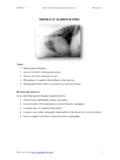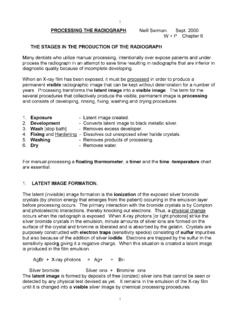Transcription of RADIOGRAPHIC PROCESSING FACILITIES AND MATERIALS 3-5 ...
1 RADIOGRAPHIC PROCESSING FACILITIES AND MATERIALS . 3-5. GENERAL. Precise methods in the PROCESSING of x-ray films are as important in attaining good results, as is the use of precise exposure technique. Regardless of the method (automatic or manual) used by the dental specialist, if proper PROCESSING procedures are followed, quality radiographs will result. 3-6. DARKROOM. a. Construction. Since x-ray films are more sensitive to light than most photographic films, it is important to have a good darkroom. The room need not be large, but it must be constructed so that no light can enter through cracks or crevices. An entrance built in the form of a maze to keep out light is better than a door. If the darkroom has a door, it should have an inside lock so that no one can accidentally enter while films are being processed.
2 The walls of the darkroom and the maze should be painted black to absorb light. The ceiling may be painted white so that enough illumination will be reflected when the correct type of safelight is used. The room should be supplied with both hot and cold water. The water pipes should lead to a mixing valve so the temperature of the flow can be regulated. Adequate ventilation must be provided. This can be done by forcibly changing the air with a ventilator fan. b. Cleanliness. Because of the extreme sensitivity of x-ray films, rigid cleanliness must be observed when PROCESSING films. Clean all equipment and only use for its intended purpose. The dental specialist must not spill chemicals. If chemicals are spilled, wipe up immediately and wash the area with clear water.
3 Spilled chemicals that are not wiped up will evaporate and leave a precipitated concentrate that contaminates films. Wash the thermometers and film holders thoroughly before transferring them to either the developing or fixing solutions. Film hangers require particular attention after films have been removed from them. If a hanger is not washed properly, the fixing solution dries on it. Then, when new films are placed on the hanger and immersed in the developing solution, the dried fixing solution runs down onto the films and causes streaked or spotted radiographs. It also contaminates the developing solution. c. Thermometer. Since films must be processed at an exact and predetermined temperature, a thermometer is needed to register the temperature of the solutions.
4 D. Timer. Because of the direct relationship between temperature and time in PROCESSING , the dental specialist must know the exact time and any given film is to be left in each solution. A. good watch may be used for this purpose, but it is much better to use an interval timer. The interval timer is a small clock giving the time in minutes and fractions of minutes. When set for the exact time required for development, it sounds an alarm at the expiration of that time. e. Film Holders. There are three types of film holders. The frame type is used for extraoral films and the clip and hinge types are used for intraoral films (see figure 3-2). Figure 3-2. Film holders for PROCESSING intraoral and extraoral films.
5 F. Illumination. A photographically safe light must be used to illuminate the darkroom. The standard for a safelight is that it must be possible to permit underdeveloped film to be exposed to the light at a distance of 4 feet for 1 minute without the least evidence of fogging. g. Sink. A sink is useful in the darkroom for mixing solutions, washing hands, and disposing of used chemicals. Remember that the fixing solution is not disposed of like other chemicals. It is retained for silver recovery. h. Solutions. There are two types of PROCESSING solutions. One is used for the automatic processor and another for the manual processor. They are not designed to work interchangeably. Before changing the PROCESSING solutions, check the manufacturers'.
6 Instructions to be sure that you have the proper chemicals for the processor you are using. Also, follow manufacturers instruction when preparing them. Some will require several chemicals mixed with water while others may be used directly from the container. 3-7. AUTOMATIC PROCESSOR. The automatic processor (see figure 3-3) is used by most dental treatment FACILITIES . Following exposure, the film is unwrapped in the darkroom and immediately loaded into the automatic processor. The unit consists of rollers and compartments filled with chemical solutions through which the film advances. At the end of the PROCESSING cycle, the film is released. The cycle duration varies from 4 to 6 minutes. a. Preventive Maintenance.
7 Preventive maintenance is the key for keeping this machine operational. The operator must adhere to the daily, weekly, and monthly maintenance schedule as prescribed by the manufacturer. Figure 3-3. Automatic processor. b. Operation. There are several automatic processors on the market today. Each machine has a slightly different design as well as maintenance and operational requirements. Therefore, you must consult the operator's manual; otherwise a very expensive piece of equipment may be damaged. 3-8. MANUAL PROCESSING . The manual processor uses the standard time-temperature method and small containers of the different PROCESSING solutions. The dental specialist should be familiar with the manual processor in case the automatic processor is not available.
8 The manual processor will allow the dental specialist to continue providing support to the dentist without interrupting patient treatment. NOTE: Manual PROCESSING is the primary method whereby film will be processed when field equipment is used. a. PROCESSING Tank. The PROCESSING tank most commonly used in dental clinics has three compartments (see figure 3-4). The compartment to the left contains the developing solution, water is in the center compartment, and the fixing solution is on the right. In addition to the three compartments, a source of hot and cold water, a drain, an overflow valve, and a cover are needed. The water is adjusted to the proper temperature and is allowed to circulate in the middle compartment and pass from the tank by the overflow valve.
9 This action provides temperature controls to the developing and fixing solution. b. PROCESSING Procedures. In order to produce a RADIOGRAPHIC image, the PROCESSING procedure for the film is sequenced as follows: developing, rinsing, fixing, washing, and drying. The quality and diagnostic value of radiographs depend upon proper PROCESSING procedures. Figure 3-4. Tank for PROCESSING dental film. c. Developing. All equipment should have a definite place in the darkroom to facilitate handling when the user is working by the safelight only. Steps used when developing film are as follows: (1) Wash gloved hands, so that hands are clean and dry. This is to prevent the appearance of finger marks on the developed film.
10 (2) Remove the lightproof wrapper from the film. NOTE: Dispose of contaminated wrappers in accordance with (IAW) local standing operating procedures. (3) Place the film on the film holder. The film should be held lightly by its edges to avoid the appearance of smudges or fingerprints on the developed film. They may appear even when the hands are clean. (4) Set the interval timer (clock) for the prescribed developing time. Timer should start when the film is placed in the developing solution (developer). NOTE: The recommended temperature for the developing solution is 68 F (20 C). At this temperature, most films should be left in the developer exactly 4 1/2 minutes. Without adequate equipment, 68 F. (20 C) cannot always be obtained.







